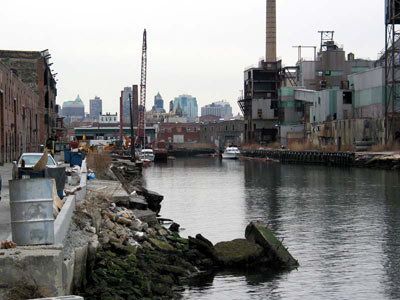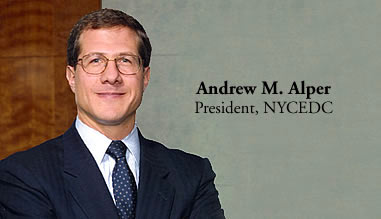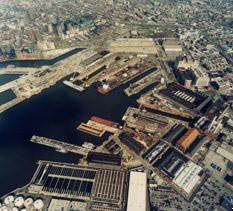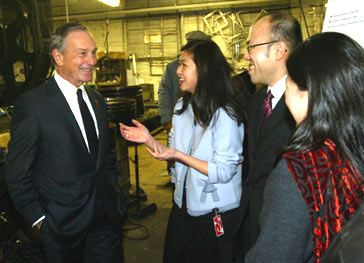for Big Apple Manufacturers
by JACK
LYNE, Site Selection Executive Editor of Interactive Publishing
 |
| "We believe that our new industrial initiatives will stem this tide and grow our manufacturing sector," said Mayor Michael Bloomberg (shown while announcing the initiative in East Brooklyn). |
NEW YORK — New
York City is intent on keeping its half-a million-job manufacturing
sector alive, well and contentedly inside the Big Apple.
Mayor Michael Bloomberg (R) has announced
a broad-ranging plan that will provide the city's industrial sector
with both financial and logistical assistance. The initiative's subsidies
certainly aren't huge. But the program's support could still register
substantial impact, for New York's manufacturers aren't a deep-pocketed
bunch. Small companies account for almost all of the city's industrial
jobs.
Bloomberg in his Jan. 12th State of the City
address details his plans for "diversifying our economy." A new industrial
emphasis, he said, was in the works as part of that initiative.
"Diversification, though," he pointedly emphasized
during his speech, "also means industry."
The full-blown plan surfaced on Jan. 19th,
when the mayor and other city officials unveiled the details in Brooklyn.
The announcement was made at the East New York neighborhood property
that's currently occupied by Arc Metal Group, a
local manufacturer that's expanding.
"Today," said Bloomberg, "we are launching
a comprehensive industrial policy that involves designing new business
zones and creating new incentives to encourage long-term investment
in manufacturing, warehousing and other industrial businesses throughout
the five boroughs."
"Over the past half century, the city's industrial
base has declined, along with many other American cities," he continued.
"But the industry remains a powerful engine of our economy. Its 500,000
jobs represent about 15 percent of our work force. We believe that our
new industrial initiatives will stem this tide and grow our manufacturing
sector."
 |
| New York's new Industrial Business Zones will include part of the Red Hook neighborhood. (Pictured: part of the pier area in Red Hook.) |
"Mayor Bloomberg's economic development strategy focuses on three key initiatives: making the city more livable, more business-friendly and diversifying our economy," said Andrew Alper, president of the New York City Economic Development Corporation (www.newyorkbiz.com). "Improving business conditions for our critical manufacturing sector touches on all three. This new policy will help us create a better partnership with the city's many industrial companies and create the proper conditions to catalyze job growth."
New York City is investing some $17 million in the manufacturing program through 2009, city officials said. During that same period, they explained, the Big Apple will provide about $9 million in projected
 |
| "Improving business conditions for our critical manufacturing sector touches on all three key initiatives in Mayor Bloomberg's economic development strategy," said Andrew Alper (pictured), president of the New York City Economic Development Corporation. |
The IBZs will be designated, city officials explained in a release accompanying the program's announcement, "based on existing land uses, the industrial character of the neighborhood, traffic patterns and Empire Zone boundaries." (Companies locating and/or expanding in a state Empire Zone are eligible for sales tax exemption and real property and business tax credits for 10 to 15 years.)
The city has already identified some of the IBZs, reported Carl Hum, the newly appointed director of the OIMB. Neighborhoods in which zones have been established, he explained, include the following: Bathgate; East New York; Eastchester; Flatlands; Hunts Point; Jamaica; JFK Industrial Corridor; Long Island City; North Brooklyn; Port Morris; Southwest Brooklyn including Sunset Park and parts of Red Hook and Gowanus; Steinway; West Maspeth; and Zerega. Other IBZs will be designated, Hum said.
"Even with the challenges of a global economy and changing urban landscape, the industrial sector still manages to significantly contribute to the city's economy and provide gateway employment for many workers with minimal skills and limited English proficiency," said Hum, the former SBS chief of staff and special counsel. "The Office of Industrial and Manufacturing Businesses will not only help retain current businesses but help them grow and attract even more businesses to New York."
 |
| In addition to the new Industrial Business Zones, the Brooklyn Navy Yard (pictured) is one of the locations to which companies can move and qualify for New York City's one-time relocation tax credits. The federal government closed the Brooklyn Navy Yard in 1966. |
Other program initiatives will expand the city's services in helping companies recruit, screen and train employees, said Hum. The idea, he explained, is to help industrial businesses reduce labor costs and access employee-training funds.
The OIMB will offer $1 million in grants for industry-specific training programs or for special initiatives that bring services closer to industrial businesses, Hum said. The grants, he added, will also be offered for technical assistance to help industrial businesses access additional state training grants.
Arc Metal, which makes retail displays, architectural metal detail and custom furniture, is taking advantage of the city's existing manufacturing support programs in its expansion. The city's Industrial Development Agency (IDA at www.newyorkbiz.com/nycida) is providing $730,000 over 25 years to assist the company in buying the building it now leases. The aid — which includes a mortgage recording tax waiver, and real estate and sales tax abatements — will enable the company to expand and remain competitive with companies in less expensive locations, IDA officials explained.
Of Future Zoning Decisions
"By making an ironclad commitment to maintain manufacturing zoning in key industrial areas and not
 |
| Newly appointed OIMB Director Carl Hum (pictured second from right), whose parents worked in New York manufacturing jobs, said that "my connection to [this] sector in the city runs deep. . . . If it wasn't for these jobs, my sisters and I never would have been able to go to college and pursue our careers." |
The city is also cracking down on illegal conversions of manufacturing space into housing, said Bloomberg. New York is now prominently promoting reporting such violations through its 311 phone hotline. In addition, the city is raising its fines for conversion-related infractions, New York officials said.
The city's new manufacturing support includes enhancing sanitation services, creating a new "dumpster shed" program. The city now offers its businesses the option of building a shed on the sidewalk to store dumpsters for trash disposal. But that program, city officials conceded, is "a lengthy, expensive and burdensome process" that takes a year to complete on average. The new plan, they promised, will lower costs and streamline processes, cutting the time to build a shed to six months.
Hum brings strong familial roots to the OIMB's mission.
"My connection to the industrial and manufacturing sector in the city runs deep," he explained. "I grew up in Sunset Park, Brooklyn, and my parents were both employed in the sector.
"My father pressed shirts in Greenpoint, Brooklyn, and my mother was a seamstress in Chinatown," Hum continued. "In fact, if it wasn't for these jobs, my sisters and I never would have been able to go to college and pursue our careers."
 PLEASE
VISIT OUR SPONSOR • CLICK ABOVE
PLEASE
VISIT OUR SPONSOR • CLICK ABOVE  ©2005 Conway Data, Inc. All rights
reserved. Data is from many sources and is not warranted to be
accurate or current.
©2005 Conway Data, Inc. All rights
reserved. Data is from many sources and is not warranted to be
accurate or current.